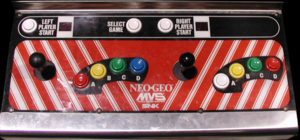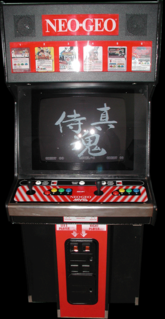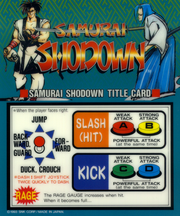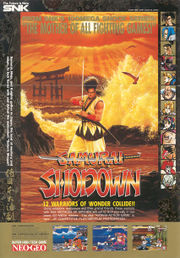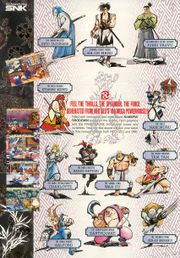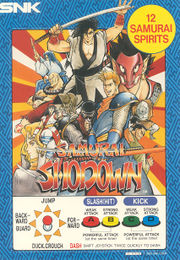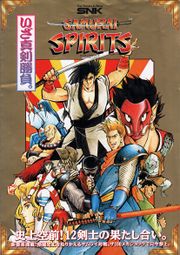Lost In Translation/Samurai Shodown
| Samurai Shodown | |
|---|---|
| Manufacturer | SNK |
| Released | 1993 |
| Control Method |
8-way Joystick 4 Button(s) |
| Main CPU | Neo-Geo 68000 (@ 12.000 MHz) Z80 (@ 4.000 MHz) |
| Sound CPU | Stereo YM2610 (@ 8.000 MHz) |
| Video Details |
Raster (Horizontal) 320 x 224 pixels 59.19 Hz 4,096 Palette colours |
| Screens | 1 |
| ROM Info | 24 ROMs 16,842,752 bytes (16.06 MiB) |
| MAME ID | samsho |
About The Game
Samurai Shodown is a one-on-one fighting, weapon-based arcade video game that put the Neo-Geo on the map! Featuring 12 characters, bonus rounds and one end boss.
Additional Technical Information
Players : 2
Control : 8-way joystick
Buttons : 4
=> With weapon : [A] Light attack, [B] Medium attack
=> Without weapon : [A] Light punch, [B] Medium punch, [C] Light kick, [D] Medium kick
Trivia
Released in July 1993.
The game is known in Japan as "Samurai Spirits (SNK)".
Samurai Shodown is the first game that introduced weapon fighting into the fighting game genre. The game used an upgraded version of the scaling graphics engine that was originally featured in "Art of Fighting".
Samurai Shodown also started SNK's reputation for their unique style of Engrish, known as SNKgrish in their games.
Unlike "Mortal Kombat", the usage of blood in this game is generally accepted, and the decision to replace blood with 'white blood' remains a sore point among fans of this series.
Samurai Shodown is considered by some to portray Japanese culture and language effectively. Unlike most American versions of Japanese video games, the characters in this game (including the announcer) generally speak fluent Japanese with subtitles, and traditional Japanese music is often heard during game-play. Samurai Shodown takes most of its characters from either historical sources or characters from the Ninja Scroll anime. In fact, a few designers that worked on Samurai Shodown also worked on the Ninja Scroll anime...
Haohmaru is based on the legendary samurai Miyamoto Musashi (1584-1645), whose fighting philosophy heavily influenced that of the Haohmaru character.
Ukyo Tachibana is based on Sasaki Kojiro Genryu (1572-1612), Musashi's skilled rival.
Jubei Yagyu is based on the historical Yagyū Jūbei Mitsuyoshi (1606-1644), who was a sword instructor to the Tokugawa shogunate. The Yagyu clan was a famous clan of samurai.
Hattori Hanzō Masashige (1541-1596) was the most famous of the Iga Ninja clan. He was a genius at leading night raids on forts and fiefs and became a feared assassin. Under his leadership, Iga Ninja became so notorious that Nobunaga felt it necessary to obliterate the Iga Ninja clan.
Wan-Fu seems to be a combination of two famous Chinese warriors. The first is a famous Chinese swordsman who was a rebel during the Ch'ing Dynasty. His name was Wang Ts-bin Wu, but he became known as Da Dao Wang Wu ('Big Scimitar Wang Wu'). The second lead bases Wan Fu upon the ancient, almost legendary, founder of the Chou Dynasty, King Wu Wang.
Kyoshiro Senryo is based on Nemuri Kyoshirō, a fictional character created by Shibata Tosaburo. 'Kyoshiro' translates to something like 'deranged fellow'. Tosaburo's Kyoshiro had nothing to do with kabuki theatre as does Samurai Shodown Kyoshiro. Kyoshiro's weapon is called a naginata.
Charlotte is based on a character in the manga 'The Rose of Versailles' by Riyoko Ikeda (1972).
Gen-an Shiranui looks much like Mushizo, the hunchback demon of Ninja Scroll. Gen-an's weapon is modelled after the weapon wielded by Shijima, the shadow demon, from Ninja Scroll. Although they share a surname, Gen-an is not a relative of Mai Shiranui of the Fatal Fury/King of Fighters series.
Amakusa Shiro Tokisada (1622-1638) led a Christian uprising against the Tokugawa shogunate in the Shimabara region of Japan.
Nakoruru is a homage to Sailor Moon.
A 'Kuroko' is a traditional Kabuki theatre stage-hand. They are traditionally dressed in black and took care of scenery and other behind-the-scenes needs during a Kabuki performance, just like modern theatre stage-hands. In the case of Samurai Shodown, Kuroko is the referee for each match in Samurai Shodown I and II. The black strip of fabric hanging over a Kuroko's face is to signify that they are not part of the Kabuki performance, just helping with the props. The red and white flags that Kuroko has are used in traditional martial arts matches, where each successful hit gets the corresponding fighter's flag raised.
Mai Shiranui (of Fatal Fury) appears in Haohmaru's and Gen-An's endings.
Pony Canyon / Scitron released a limited-edition soundtrack album for this game (Samurai Spirits - PCCB-00135) on 17/09/1993.
Tips and tricks
Alternate Costume Colours
Highlight a fighter at the character selection screen and press D.
Sleeping Mamahaha
This is just hilarious! To see this while playing as Nakoruru simply stand still, after a 8 seconds or so Mamahaha will land on Nakoruru's shoulder, start yawning and then it will fall asleep!
Poppy's Puppies
To see a truly cool & funny secret pose with Galford, Get a PERFECT against an opponent while unarmed. You must finish the battle with anything except a throw though!
Tam Tam's Broken Ending
If you use continues while beating the game with Tam Tam, you will miss a part of the whole ending (You can't see his real face). Beat the game with one credit in order to see his face.
Wan-fu's Sword Explosion Bug
While playing as Wan-fu trap an enemy against the edge of the screen then perform the Explosive Sword Drop with the B button (HCB + B) to throw the sword and land next to the opponent. Since most players as well as the CPU are likely to block the move, crouch and hit them with the C button (a short kick). This will make the move unblock-able and causes tons of damage!
Cut-proof Characters?
Sometimes a finishing slash will cut most opponents in half, however some characters (these being Kyoshiro & Amakusa) cannot be cut in half!
Series
- Samurai Shodown (1993)
- Samurai Shodown II (1994)
- Samurai Shodown III (1995)
- Samurai Shodown IV - Amakusa's Revenge (1996)
- Samurai Shodown 64 (1997)
- Samurai Shodown 64 - Warrior's Rage (1998)
- Samurai Shodown V (2003)
- Samurai Shodown V Special (2004)
- Samurai Shodown - Tenkaichi Kenkakuden (2005)
- Samurai Shodown - Edge of Destiny (2008)
Staff
- Executive Producer
- Eikichi Kawasaki
- Main Producer
- Rocket Queen
- Producers
- Bonehead Ken
- Satoppe-
- Tomi Yan
- Fukui Tomoaki
- Front Designers
- Violetche Nakamoto
- Miki
- Masami Tanaka
- K.Shintani-F91
- Go-Go (Dave Bros)
- Kazu
- The.Fool
- Ryu! (Dave Bros)
- Erina.Makino
- Back Designers
- Fukui Tomoaki
- AAA
- Keisen (as Oshioki-Keisen)
- Yasupuu
- N. Azumi (as N. Azumichan)
- Okap-
- Mayu K.
- Erina.Makino
- Programmers
- Nishidon
- K2
- Zombi Abe
- Cyber Kondo
- Z'N
- Music
- Tate Norio
- Masahiko Hataya (Papaya)
- Submissions
- Ryu! (Dave Bros)
- AAA
- Miki
- Okap-
- The.Fool
- Mayu K.
- Erina.Makino
Character designers
- Jubei Yagyu
- Masami Tanaka
- Miki
- Kuma.Bee
- Kazu
- Earthquake
- Go-Go (Dave Bros)
- K.Shintani-F91
- Kazu
- Hanzo Hattori
- Violetche Nakamoto
- Keisen (as Oshioki.Keisen)
- K.Shintani-F91
- N. Azumi (as N. Azumichan)
- The.Fool
- Erina.Makino
- Ukyo Tachibana
- Kazu
- The.Fool
- Wan-fu
- Go-Go (Dave Bros)
- K.Shintani-F91
- The.Fool
- Ryu! (Dave Bross)
- Gen-an Shiranui
- K.Shintani-F91
- Keisen (as Oshioki-Keisen)
- N. Azumi (as N. Azumichan)
- Ryu! (Dave Bross)
- The.Fool
- Galford
- Violetche Nakamoto
- Keisen (as Oshioki-Keisen)
- K.Shintani-F91
- N. Azumi (as N. Azumichan)
- The.Fool
- Erina.Makino
- Kyoshiro Senryo
- Kazu
- Erina.Makino
- Tam Tam
- Miki
- Masami Tanaka
- Go-Go (Dave Bros)
- Haohmaru
- K.Shintani-F91
- Erina.Makino
- Nakoruru
- Violetche Nakamoto
- Keisen (as Oshioki-Keisen)
- The.Fool
- Shirou Tokisada
- Miki
- Charlotte & Poppy
- Kuwa.Bee
- Mamahaha
- Erina.Makino
Voice Actors
- Haomaru, Hanzo Hattori, Galford & Earthquake
- Masaki Usui
- Jubei Yagyu & Wan-Fu
- Takayuki Sakai
- Ukyo Tachibana, Gen-an Shiranui & Shiro Tokisada Amakusa
- Eiji Yano
- Kyoshiro Senryo & Tam Tam
- Kazuhiro Inage
- Nakoruru & Charlotte
- Harumi Ikoma
Cabinet and Artwork
Ports
- Consoles
- Sega Mega CD (1993)
- Nintendo Super Famicom (1994)
- Nintendo Game Boy (1994)
- Sega Mega Drive (1994)
- Sega Game Gear (1994)
- SNK Neo-Geo CD (1994)
- REAL 3DO (1995)
- Sony PlayStation (1998, "Samurai Spirits - Kenkaku Yubinan Pack")
- FM Town Marty
- Others
- Mobile Phones (2004)
Soundtrack Releases
| Album Name | Catalogue No. | Released | Publisher | Comments |
|---|---|---|---|---|
| Samurai Spirits Image Album | PCCB-00147[1] | 1994-02-18 | Pony Canyon, Inc. | CD version. |
| Samurai Spirits | PCCB-00135[2] | 1993-09-17 | Pony Canyon/Scitron | CD version. |
| Samurai Spirits Symphonic Sound Trax | PCCB-00198[3] | 1995-11-17 | Pony Canyon | CD version. |
| NEO SELECTION - NEO-GEO Fighting Tournament Best / SNK.ADK | PCCB-00141[4] | 1993-12-17 | Pony Canyon/Scitron | CD version. |
| Neo•Geo Super Live! 1994 | PCCB-00161[5] | 1994-10-05 | Pony Canyon | CD version. |
| Samurai Remix | PCCB-00174[6] | 1995-03-01 | Pony Canyon/Scitron | CD version. |
| NEO-GEO DJ Station | PCCB-00244[7] | 1997-01-18 | Pony Canyon/Scitron | CD version. |
| SNK Character Sounds Collection Volume 2 ~ Nakoruru | PCCB-00269[8] | 1997-07-18 | Pony Canyon/Scitron | CD version. |
| Samurai Spirits Drama CD | PCCB-00300[9] | 1998-03-04 | Pony Canyon/Scitron | CD version. |
| Scitron 10th Anniversary Special: Samurai Spirits THE BEST -Selected by Characters- | PCCB-00326[10] | 1998-09-18 | Pony Canyon/Scitron | CD version. |
| SNK Character Sounds Collection Volume 9 - Rimururu | PCCB-00348[11] | 1998-12-02 | Pony Canyon/Scitron | CD version. |
| NEO-GEO DJ Station 2 ~ B.O.F. Returns | PCCB-00361[12] | 1999-03-03 | Pony Canyon/Scitron | CD version. |
| NEO-GEO DJ Station Live '99, SNK Presents | PCCB-00374[13] | 1999-05-19 | Pony Canyon/Scitron | 2 CD version. |
| NEO GEO DJ Station in Gemudora night ! | SCDC-00029[14] | 2000-07-19 | Scitron | CD version. |
| Super Famicom Magazine Volume 15 - Starting with Famous Music!! Final Fantasy VI & New Game Sound Museum | TIM-SFC15[15] | 1994-03-01 | Tokuma Shoten Publishing | CD version. |
| Scitron 10th Anniversary Special CD Sampler | DMCZ-300098[16] | 1998-01-01 | Scitron Label | 2 CD version. |
| Dengeki CD Bunko Best Game Selection 9 - Samurai Spirits ~Hihou Ruten Shimaki~ | MWCG-0011[17] | 1994-06-25 | Media Works | CD version. |
| Dengeki CD Bunko Best Game Selection 8 - Samurai Spirits ~Jashin Hukkatsu Shimaki~ | MWCG-0008[18] | 1994-01-25 | Media Works | CD version. |
| Dengeki CD Bunko Best Game Selection 16 - Samurai Spirits ~Kenma Taisen Shimaki~ | MWCG-0013[19] | 1994-10-25 | Media Works | CD version. |
| SAMURAI SPIRITS NEOGEO's SOUNDTRACK COLLECTION BOX | DECX-0011~5[20] | 2004-07-12 | DEX Entertainment | 5 CD version. |
| Gaesen Oh - Scitron Game Music Mega Mix Vol.1 | KGCD-0001[21] | 1994-01-01 | Pony Canyon/Scitron | CD version. |
| Super Famicom Magazine Volume 22 - New Game Sound Museum | TIM-SFC22[22] | 1994-09-01 | Tokuma Shoten Publishing | CD version. |
| NEO-GEO DJ Station Live '99, SNK Presents | PCLP-00703[23] | 1999-06-02 | Pony Canyon, Scitron Label | |
| NEO-GEO DJ Station Live '99, SNK Presents | PCVP-12619[24] | 1999-06-02 | Pony Canyon, Scitron Label | Released on VHS. |
References
- ↑ Samurai Spirits Image Album (CD) at the VGMdb
- ↑ Samurai Spirits (CD) at the VGMdb
- ↑ Samurai Spirits Symphonic Sound Trax (CD) at the VGMdb
- ↑ NEO SELECTION - NEO-GEO Fighting Tournament Best / SNK.ADK (CD) at the VGMdb
- ↑ Neo•Geo Super Live! 1994 (CD) at the VGMdb
- ↑ Samurai Remix (CD) at the VGMdb
- ↑ NEO-GEO DJ Station (CD) at the VGMdb
- ↑ SNK Character Sounds Collection Volume 2 ~ Nakoruru (CD) at the VGMdb
- ↑ Samurai Spirits Drama CD (CD) at the VGMdb
- ↑ Scitron 10th Anniversary Special: Samurai Spirits THE BEST -Selected by Characters- (CD) at the VGMdb
- ↑ SNK Character Sounds Collection Volume 9 - Rimururu (CD) at the VGMdb
- ↑ NEO-GEO DJ Station 2 ~ B.O.F. Returns (CD) at the VGMdb
- ↑ NEO-GEO DJ Station Live '99, SNK Presents (CD) at the VGMdb
- ↑ NEO GEO DJ Station in Gemudora night ! (CD) at the VGMdb
- ↑ Super Famicom Magazine Volume 15 - Starting with Famous Music!! Final Fantasy VI & New Game Sound Museum (CD) at the VGMdb
- ↑ Scitron 10th Anniversary Special CD Sampler (CD) at the VGMdb
- ↑ Dengeki CD Bunko Best Game Selection 9 - Samurai Spirits ~Hihou Ruten Shimaki~ (CD) at the VGMdb
- ↑ Dengeki CD Bunko Best Game Selection 8 - Samurai Spirits ~Jashin Hukkatsu Shimaki~ (CD) at the VGMdb
- ↑ Dengeki CD Bunko Best Game Selection 16 - Samurai Spirits ~Kenma Taisen Shimaki~ (CD) at the VGMdb
- ↑ SAMURAI SPIRITS NEOGEO's SOUNDTRACK COLLECTION BOX (CD) at the VGMdb
- ↑ Gaesen Oh - Scitron Game Music Mega Mix Vol.1 (CD) at the VGMdb
- ↑ Super Famicom Magazine Volume 22 - New Game Sound Museum (CD) at the VGMdb
- ↑ NEO-GEO DJ Station Live '99, SNK Presents at the VGMdb
- ↑ NEO-GEO DJ Station Live '99, SNK Presents (VHS) at the VGMdb




